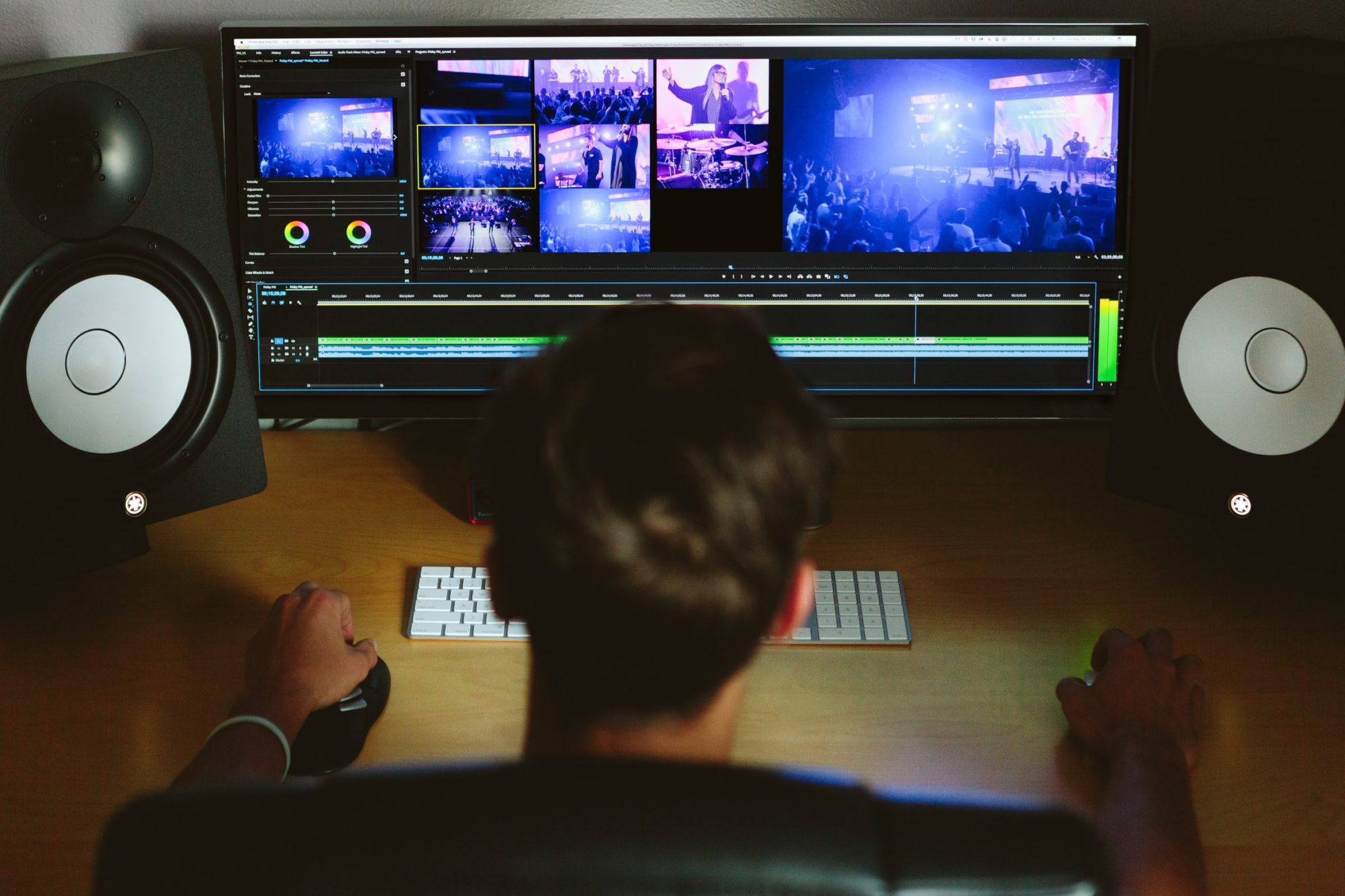Building a home recording studio is a fun and challenging project. You’ve gotten your hands on a DAW, audio interface, but now you need some proper monitors to… well… monitor. But which studio monitors are genuinely the best studio monitors for mixing?
Any good monitor should have a true, flat sound. Commercial speakers change the sound balance for the consumer market, but that’s not what we want in a studio monitor. When we’re just relaxing and listening to music, this may not matter quite as much. When we are editing, we need to get a faithful representation of our work.
What are the best monitors for quality music production?
As with any piece of equipment, the options are endless. It’s tough to know which one to go with, especially when there are tons of reviews to sift through.
One thing to keep in mind is that everyone has their own preferences. Some prefer a certain set of features or specs, such as a certain decibel level or a quality sound for the low frequencies. Still, others will need studio monitors that are capable of fitting in a tight space (or just as often, in a tight budget). Size, specs, features, and value for money: how do you know which studio monitor is right for you?
In this article, we’ll cover some of our favorite monitors, and attempt to give you some peace of mind during these trying times. I go into detail about why I made the picks that I did, and I’ll also include some pros and cons that may help you choose between your top choices.
The Best Studio Monitors for Mixing | Frequently Asked Questions
Before I unveil the results of our survey––at the bottom, if you want to skip ahead––I thought we’d add a few important pieces of guidance for the absolute beginner. There’s a lot of terminology surrounding electronics and music equipment in general, so if you haven’t delved into this topic much, it can be a bit overwhelming.
That said, if you already know all this stuff, just head down to the bottom for the results.
The best studio monitors for mixing differ from standard bookcase speakers in that they produce a flat frequency response that does not color the sound.
A good set of monitors provides accurate sound reproduction that allows you to create a mix that will sound great on anything from earbuds to auditorium loudspeakers.
Monitors allow you to isolate musical components and clean them up with ease and precision. These monitors are also designed to be used in close quarters, and they do not fill up a room with sound the way standards speakers will.
- Why Studio Monitors Instead of Normal Speakers?
- How Can You Find the Best Studio Monitors for Mixing?
- What is Frequency Response?
- What is SPL?
- Monitors Are Sold Individually…Do You Need Two Monitors for Mixing?
- What Are “Near-field” Monitors?
- What Are “Active” Monitors
- How Do I Connect Studio Monitors to My Computer?
1. Why Studio Monitors Instead Of Normal Speakers?
Consumer speakers are not intended to be “flat.” They are designed to sound “good” for casual listening. Depending on the speaker, this might mean added bass or other frequencies.
Studio monitor speakers, however, aim to be as unbiased as possible. They present the sound as close to its natural state as possible. For this reason, they’re often called “reference monitors,” because they are your reference point when you’re mixing and mastering.
(For a similar reason, reference headphones are often talked about the same way).
If you mix your tracks on speakers that aren’t “flat,” you can’t be sure that your mix will still sound good on with other speakers, headphones, and sound systems. Having a good mix is essential to producing a good song, and that means that having good monitors is essential to building an effective home studio.
The unfortunate truth is, no matter how talented you are, no matter how good your song might be, if the mix is lacking, listeners are less likely to appreciate it. Many of them may not even realize it’s because of the poor mix. But they will know that something is missing, and it won’t have that same effect on your audience.
2. How Can You Find The Best Studio Monitors For Mixing?
The best monitors provide accurate sound, which allows you to detect and correct muddiness, track volumes, and more.
You also want to pay attention to frequency response. This is a valuable measure of what your monitor’s range is going to be.
The durability and build are worth noting as well. As speakers make sound through vibrations, it’s important that your monitors hold together through these vibrations. Otherwise, your ears will be plagued with rattling.
3. What Is Frequency Response?
Frequency response is the range of frequencies the monitor is capable of replicating. Human beings can hear frequencies between 20Hz and 20kHz; however, the auditory range of human beings contracts as they get older. Many top-level speakers produce frequencies outside of the auditory range.
This is because sound is made up of vibrations. Even though you cannot hear high or low vibrations, you can still feel them in the air and in the furniture. Speakers that replicate frequencies outside of the auditory range provide a sensory experience that can literally make your hair stand up.
Frequency Response Test
If you are curious about your own auditory range, there are a whole series of frequency test recordings on YouTube that increase at intervals of around 10Hz. Don’t be too concerned if you can’t hear them. The issue could be that the speakers on your computer cannot replicate the frequencies.
But, it can be interesting to test your speakers to see if the speakers you purchase actually perform up to the manufacturer’s claims. Get a second opinion if it seems the speakers don’t perform, because the silence could be due to hearing loss and not a faulty speaker (I have quite a few frequencies that I can no longer hear).
4. What Is SPL?
SPL stands for sound pressure level. High SPL doesn’t mean a set of speakers is necessarily among the best studio monitors for mixing, because (contrary to popular belief) mixing doesn’t require high volume. Really, you should be mixing your music at a conversational level.
SPL is a measure of how loud a set of speakers is, and most speakers are capable of an uncomfortable volume level. So SPL isn’t terribly important here.
5. Do You Need Two Monitors for Mixing?
So, you noticed that monitors are not generally sold in pairs.
You are correct.
So do you really need two monitors for mixing? Yes.
Most professional mixing is done in stereo, which requires two speakers.
Mixing on a single track is called mono, and believe it or not, it was the industry standard for years. The Beatles’ first stereo album was The White Album, released in 1968. Before then, all their work was mixed in mono.
While mixing in mono is a good trick to ensure your mix doesn’t have phasing issues, you need the ability to switch back to stereo. There’s a reason that we mix solely in mono anymore. Nowadays, we want to be able to control the listener’s sense of where the sound is coming from. That feeling can only be simulated if you have a stereo system in play. Without it, you are missing out on a big part of contemporary music production, and it’s likely to leave your final product feeling flat. You are going to need a pair of studio monitors, because many of your listeners are going to be hearing the song in stereo themselves.
So unless you intend to mix like it’s the 60’s, be sure to verify whether the monitor set you wish to buy is a pair or a single monitor.
6. What Are Near-Field Monitors?
This is one of those questions that gets asked all the time by people who are just starting out.
When you’re confronted with the question of what sort of monitors to buy, you’re going to find encounter the terms “near field,” “mid field,” or “far field.” It’s not a difficult concept, but if you don’t know what it means, it could make you hesitant to make a purchase, and unsure if you’re getting the right piece of equipment for your own purposes.
Simply put, near-field monitors are designed to sit close to the person who is listening to them. They produce sound in such a way that the ideal distance for the listener is only a few feet. Mid field monitors, meanwhile, are larger and designed for larger spaces. Far field monitors are used for big spaces like commercial theaters, and are designed for rumbling bass sounds. Great for an action movie in the cinema, but not what you want in a home studio.
So save yourself a headache. For the purpose of your home studio, you want to get a pair of near-field monitors that will ideally each sit a few feet away from you. Together, these two speakers will provide a balanced sound that is perfectly suited to a home studio setup.
7. What Are Active Monitors?
You may also come across the term “active speakers” or “active monitors,” which can be daunting if you’ve never encountered it before.
These types of speakers have built-in amplifiers that can increase the power of the speaker’s electrical signal. This requires the monitors to have some sort of power source, because the amplifier requires electricity to operate. Many studio monitors fall into the “active” category.
If you want to research amps, you can do that, but it isn’t really a high priority. Class D amplifiers are the most efficient, but a typical A/B amplifier is fairly standard and more than sufficient for most of your needs when it comes to studio monitors.
In practical terms, the biggest thing to know about “active monitors” or “powered monitors” plug into mains, while the “passive” or “unpowered” monitors do not.
8. How Do I Connect Studio Monitors to My Computer?
It wasn’t that long ago that studio equipment was much different––we’re talking about large, clunky machines that could only work in a large professional recording studio.
Nowadays, music production is digital, compact––and it can all take place in a small room as long as it’s outfitted with the right gear. And of all your tools, your home computer is going to be the one you spend the most time with.
Your computer is the command center for your music production. Of course, you’re going to want your studio monitors to be hooked up to it.
Now, there are ways of connecting studio monitors directly to your computer, but the easiest approach is to use an audio interface. This is something that every home studio should have as part of its list of essential ingredients. It makes it easy to hook up your speakers to a new machine as well (if you want to listen to a friend’s mix on their laptop, for instance, you can easily switch back and forth).
I’m a fan of simple audio interface options, especially for beginners. These will only have a couple of ports, but that’s all you need to get started. The Focusrite Scarlett 2i2 is a great one to use, and it’s a piece of equipment that will come in handy for years.
How We Reviewed These Monitors
I evaluated the speakers in our survey of the best studio monitors for mixing on a number of factors:
- Sound Quality
- Accuracy
- Frequency Response
- Tweeter/Woofer & Cabinet Size
I offered specific comments on each speaker and made our final evaluation based on the relative value. Ultimately, everyone will have their favorites, and that’s fine. But here I have picked out the best of the best, as well as the one that gives you the most bang for your buck.
Overall Price Range
The most expensive monitors provided superior sound; however, there is a point of diminishing returns where the performance increase is minimal––no matter how much more you spend.
In our survey of the best studio monitors for mixing, I found the price sweet spot to be around $1,000. The speakers in our survey ranged from $75 entry-level speakers to $1,500 speakers. Our pricing refers to the price of a single speaker, even though some studio speakers in this survey are sold as a set.
I strongly recommend that you plan to buy two monitors. If you’re mixing and mastering in your own home studio, you’re going to want to hear things in stereo. So plan accordingly as you read––the prices refer to one speaker, but in the end, you’re really going to want to purchase two of them.
What Monitors We Reviewed
- Neumann KH 120 A – Active Studio Monitor
- Focal Solo6 Be 6.5″ Powered Studio Monitor
- Adam Audio A7X Powered Studio Monitor
- Mackie HR824 MKII 8-Inch 2-Way Studio Monitor
- Yamaha HS8 Studio Monitor
- Dynaudio Acoustics BM6 MKIII Studio Monitor
- KRK RP5G3- 59107 NA Rokit 5 Generation 3 Powered Studio Monitor
- Genelec 8010 Bi-Amplified Monitor System
- Pioneer Pro DJ Studio Monitor DM-40
- M-Audio AV42 | 20-Watt Compact Studio Monitor
Neumann KH 120 A – Active Studio Monitor (SINGLE MONITOR)
Features
 Neumann has been in business since 1928, so this is a studio monitor with a major legacy in the recording industry.
Neumann has been in business since 1928, so this is a studio monitor with a major legacy in the recording industry.
The Neumann KH 120 A doesn’t disappoint with a crisp, clear sound and low-end frequency you feel in the pit of your stomach. The attractive speaker cabinet is 10.87 x 7.12 x 8.62 and weighs a light 14.3 pounds.
The 5.25-inch woofer is compact but big enough to move a solid volume of air. The 1-inch tweeter replicates high frequencies accurately. With a frequency response of 52Hz to 21kHz and a peak SPL of 111.1 dB, this is a great workstation monitor.
Pros
- Compact
- 5.25-inch woofer
- Good frequency response
Cons
- No cables included except the power cable
Price $$
Focal Solo6 Be 6.5″ Powered Studio Monitor (SINGLE MONITOR)
Features
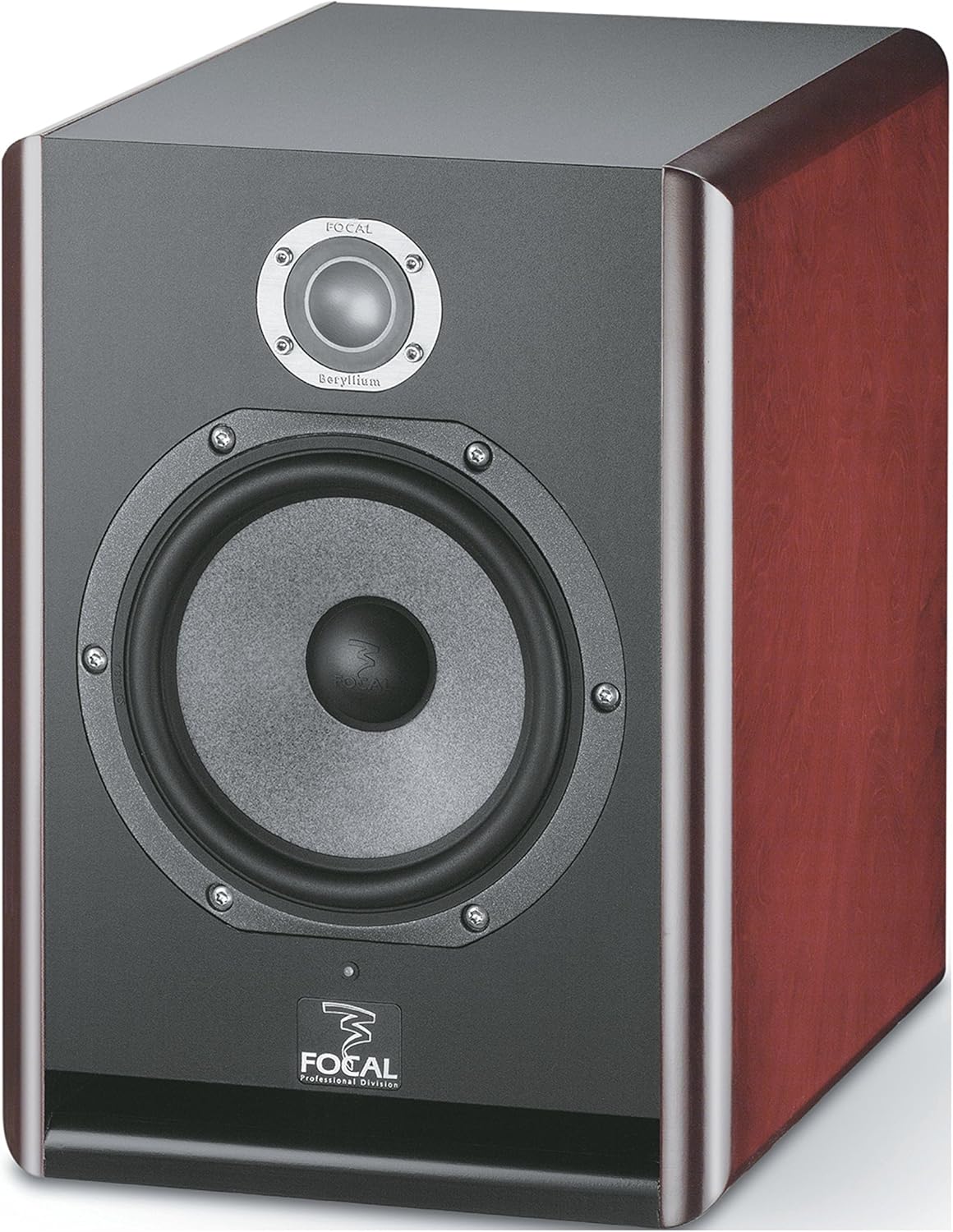 Focal consistently produces high-quality studio equipment, and the Solo6 6.5 inch powered studio monitor is no exception.
Focal consistently produces high-quality studio equipment, and the Solo6 6.5 inch powered studio monitor is no exception.
The Focal Solo6 Be has tremendous low-end frequency replication for a speaker of this size. The frequency response is 40Hz to 40kHz.
The 6.5-inch woofer is large enough to create solid air volume but small enough to fit into a compact cabinet. The 1-inch Beryllium tweeter is in a class of its own. The cabinet is attractive and measures 13 x 9.44 x 11.44 inches.
The monitor weighs 24.2 pounds. SPL is 113 dB, which is an attractive feature for a studio monitor in this range. This is a high performing, professional studio monitor.
Pros
- Beryllium tweeter
- 6.5-inch woofer
- Excellent frequency response
Cons
- Heavy, not incredibly portable
Price $$$
Adam Audio A7X Powered Studio Monitor (SINGLE MONITOR)
Features
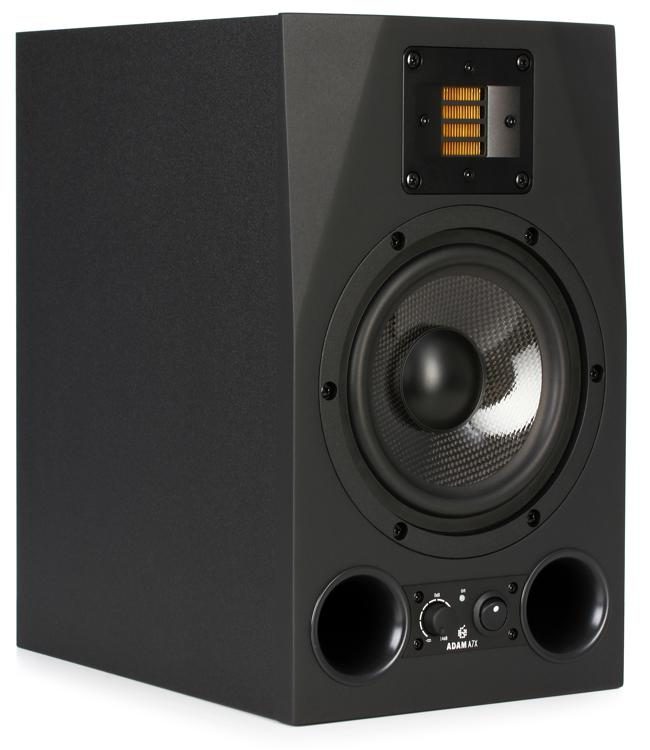 This Berlin-engineered monitor will bring famous German precision to your studio mixes. The cabinet doesn’t have the most incredible aesthetic on the market, but the 7-inch woofers blast your bass and midrange with authority.
This Berlin-engineered monitor will bring famous German precision to your studio mixes. The cabinet doesn’t have the most incredible aesthetic on the market, but the 7-inch woofers blast your bass and midrange with authority.
The cabinet size is 13.5 inches x 8 inches x 11 inches, and the unit weighs in at 20 pounds. This is a solid and durable, but not overly-awkward, monitor.
The frequency response is an impressive 42Hz to 50kHz, and the SPL is 114dB. The extended frequency response features accelerating ribbon technology that extends the high end. This is an accurate, high performing speaker.
Pros
- 7-inch woofer
- Accelerating ribbon technology tweeter
- Economically priced
Cons
- Slightly unattractive cabinet
- Power cables fit loosely
Price $$
Where to Buy
Mackie HR824 MKII 8-Inch 2-Way Studio Monitor (SINGLE MONITOR)
Features
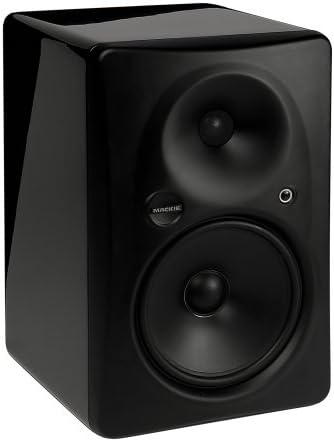 The calling card of this excellent monitor is the solid aluminum Zero Edge Baffle, which helps provide accurate, natural sound reproduction.
The calling card of this excellent monitor is the solid aluminum Zero Edge Baffle, which helps provide accurate, natural sound reproduction.
The cabinet is sleek and attractive, with dimensions of 16.8 x 10.8 x 13.8 inches. The woofer is a gigantic 8.75 inches, providing a nice and audible low end without an accompanying subwoofer.
Crisp, high-end frequencies are reproduced by the 1-inch titanium dome ferrofluid-cooled tweeter. The frequency response is 37Hz-20kHz with an SPL of 111 dB. The Mackie is a solid, high-performance studio monitor.
Pros
- 8.75-inch woofer
- Aluminum baffle
- Attractive cabinet
Cons
- Heavy
- Large, bulky speakers
Price $$
Yamaha HS8 Studio Monitor (SINGLE MONITOR)
Features
 The Yamaha HS8 features the iconic white woofer that has been emblematic of Yamaha speakers since the 1970s. Much like KRK Rokits, you’ve probably seen this iconic monitor around. In fact, the HS8 is part of a series of similar monitors, with different numbers marking the sizes of the units. The entire Yamaha product line is solid, from the HS8 all the way down to the smallest Yamaha HS5. Still, while the compact HS5 is great for those who are just starting out in music production, the HS8 is the true standout of the collection.
The Yamaha HS8 features the iconic white woofer that has been emblematic of Yamaha speakers since the 1970s. Much like KRK Rokits, you’ve probably seen this iconic monitor around. In fact, the HS8 is part of a series of similar monitors, with different numbers marking the sizes of the units. The entire Yamaha product line is solid, from the HS8 all the way down to the smallest Yamaha HS5. Still, while the compact HS5 is great for those who are just starting out in music production, the HS8 is the true standout of the collection.
This economical monitor is a great choice for individuals who are constructing their home recording studio on a tight budget. The cabinet is a compact 15.4 x 9.8 x 13.1 and weighs 22.5 pounds but features an astonishing 8-inch woofer.
The frequency response is also impressive, with a range of 38Hz to 30kHz. The advanced magnetic circuit design delivers a tightly controlled flux field that results in a very smooth sound.
One thing to keep in mind is that the Yamaha HS8 has got a rear-firing port as part of its design. In order to get the best sound, you want to place it just a little distance from the wall if possible (if not, there’s a Room Control feature which can help avoid the worst issues).
The Yamaha HS8 will give you some of the most accurate sound, especially at this price point. The sound quality is great for the cost, and the 8″ woofer helps to avoid the need to buy a separate subwoofer if that isn’t in the budget. (This is a great way of potentially saving even more money. Some music producers are going to want a dedicated woofer no matter how good the studio monitor is, but if it’s a situation where you need to save a few dollars, this is one way to do it. Get a pair of studio monitors that have a woofer that’s good enough to use until you can afford a separate woofer.)
Pros
- Economically priced
- Compact cabinet
- 8-inch woofer
- Magnetic circuit design
- Well-respected brand
Cons
- Heavy
- Distortion at high volume
Price $
Dynaudio Acoustics BM5 MKIII Studio Monitor (SINGLE MONITOR)
Features
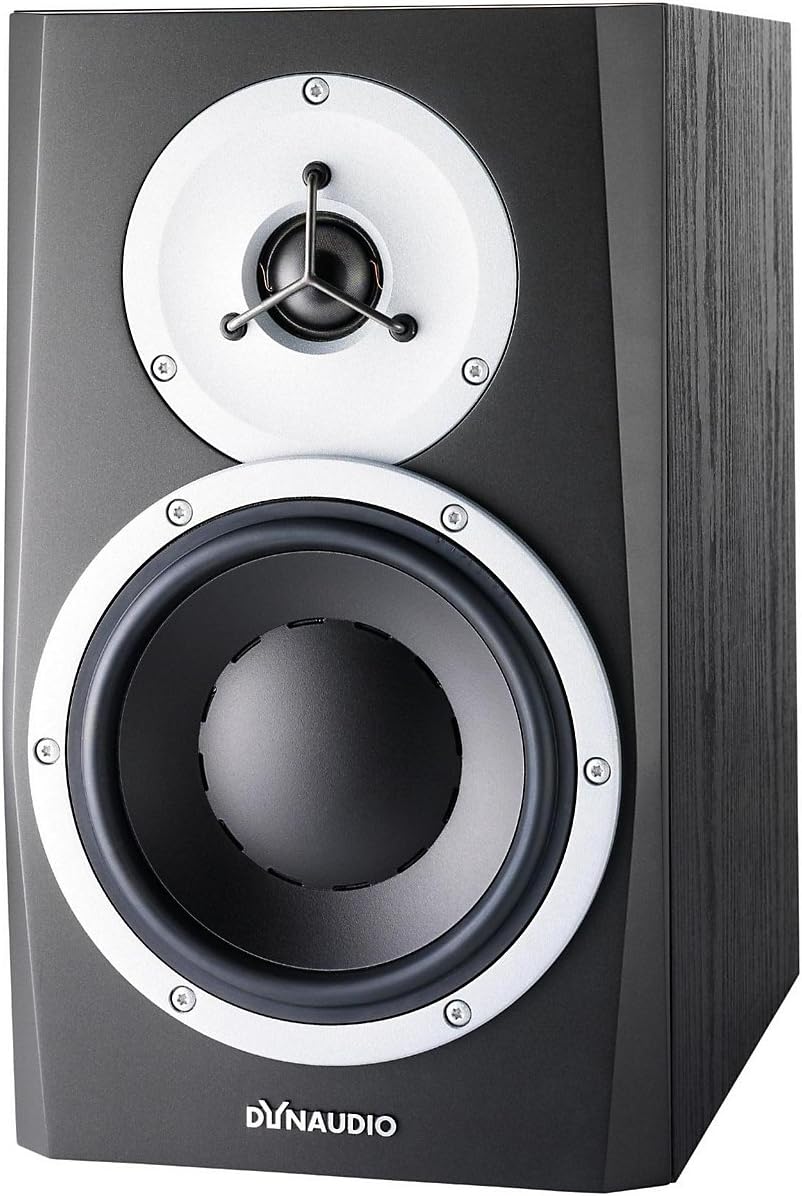 Handcrafted aluminum drivers and high-frequency waveguide technology give these beautiful speakers a well-crafted sound.
Handcrafted aluminum drivers and high-frequency waveguide technology give these beautiful speakers a well-crafted sound.
Engineered in Denmark, Dynaudio has been in business for over 35 years and only continues to surpass itself. The 7-inch woofer and the 1.1-inch dome tweeter both come with pure aluminum voice coils.
The speaker also features high, low, and mid-frequency filters to improve sound and allow you to tune your speakers to the acoustics of your room. The frequency response is 42Hz to 24kHz, and the cabinets measure 12.5 x 7.3 x 11 inches. Speakers weigh 16.9 pounds.
Pros
- 7-inch woofer
- Handcrafted aluminum drivers
- High, low and mid-frequency filters
Cons
- Volume adjustment match is sold separately
- Some consider it an overly bright sound
Price $$
KRK Rokit 8 G4 Powered Studio Monitor (SINGLE MONITOR)
Features
 The KRK RP8G4 gives you a lot of power and accuracy in a small package. These are affordably priced monitors.
The KRK RP8G4 gives you a lot of power and accuracy in a small package. These are affordably priced monitors.
Weighing in at 22.6 lbs, the 8s are ideal for mixing. The 8-inch subwoofers allow for a better frequency response, down to 35hz. They’re also ideal if you are working on a budget and have a compact recording space.
Clean sounding speakers that offer a lot of punch for a speaker this size.
Pros
- Fairly inexpensive
- Good frequency response
- Fairly lightweight
Cons
- Low air volume on woofers
Price $
Genelec 8020C Bi-Amplified Monitor System
Features
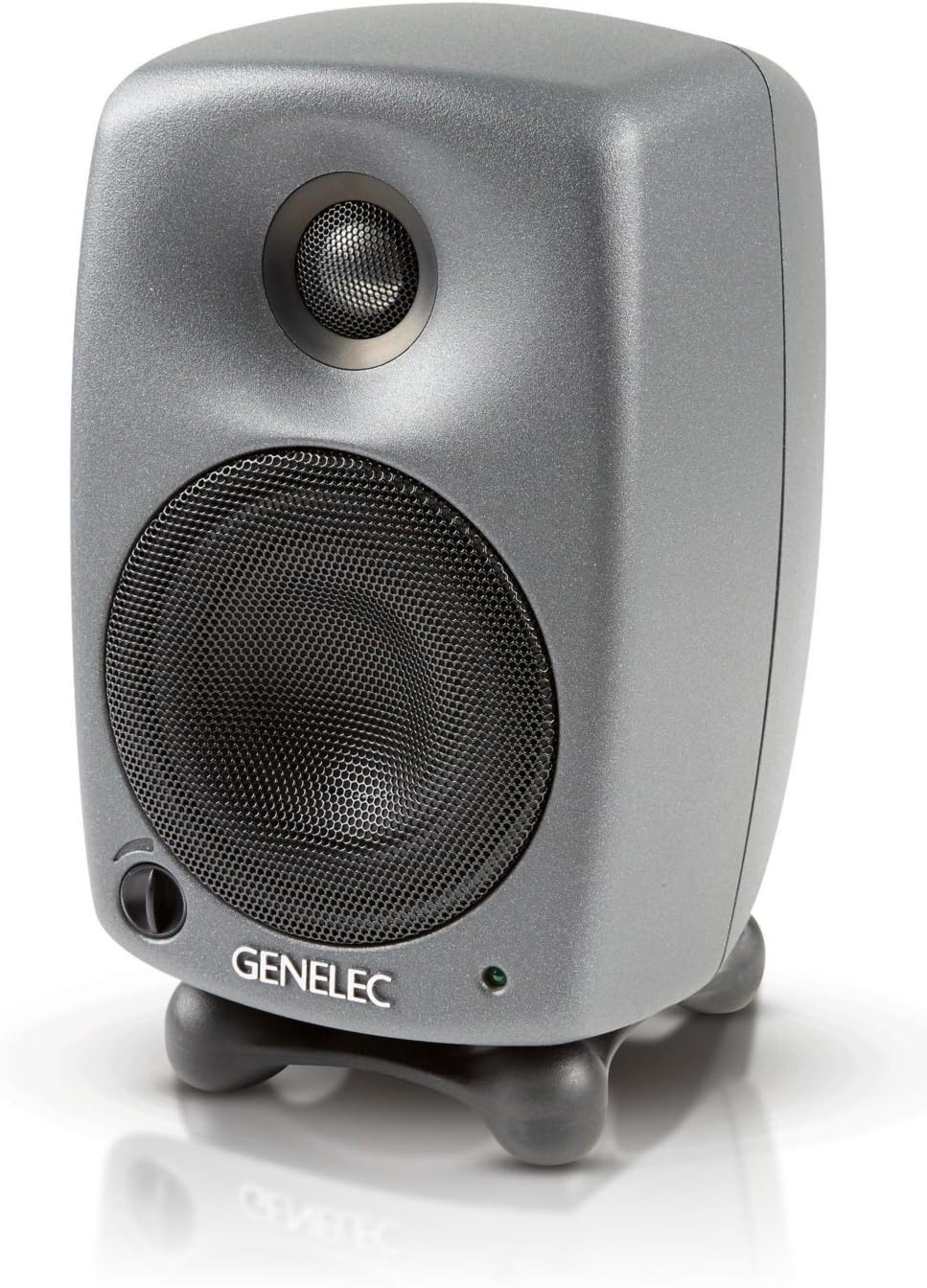 These speakers are a great choice if you have extreme space restrictions. Featuring only a 4-inch woofer and a 0.75-inch tweeter, the Genelec still produces an impressive frequency response.
These speakers are a great choice if you have extreme space restrictions. Featuring only a 4-inch woofer and a 0.75-inch tweeter, the Genelec still produces an impressive frequency response.
The range is 62Hz to 20kHz, and the tone is smooth and accurate. The cabinet weighs only 7 pounds. Mounting accessories make these monitors easy to fit anywhere.
The Iso-Pod stand prevents vibration and further improves sound performance. Pound for pound, these are the punchiest speakers in the business.
Pros
- Compact
- Lightweight
- Easy to mount
- Affordable
Cons
- 4-inch woofer doesn’t move much air
- Below average low-frequency response
Price $$
Pioneer Pro DJ Studio Monitor DM-40 (PAIR OF MONITORS)
Features
 The Pioneer Pro DJ Studio Monitor is a very affordable option for anyone who needs to record today and can’t wait to save up for a top-line set of speakers.
The Pioneer Pro DJ Studio Monitor is a very affordable option for anyone who needs to record today and can’t wait to save up for a top-line set of speakers.
At around $150 for the pair, these Pioneers are good enough to get you recording with little upfront investment. The cabinets measure 5.75 x 8.9 x 8.8 inches. The right speaker is a little larger than the left.
The right speaker weighs 6 pounds, and the left is slightly lighter. The frequency range is 70Hz to 30kHz. The impedance on these is only 10 ohms, so be careful about blowing them out when hooked to a studio amp. They feature a 4-inch woofer and a 0.75-inch tweeter.
Pros
- Affordable
- Good high-end frequency response
- Low impedance
Cons
- Few output options
- 4-inch woofer
- Below average low-end frequency response
Price $
M-Audio AV42 | 20-Watt Compact Studio Monitor (PAIR OF MONITORS)
Features
 The M-Audio AV42 is another set of affordable monitors with low impedance that are designed to get you up and working as soon as possible. At around $150 for the set, this is a great starter pair of monitors that will allow you to master the basics of learning a monitor before making a bigger investment.
The M-Audio AV42 is another set of affordable monitors with low impedance that are designed to get you up and working as soon as possible. At around $150 for the set, this is a great starter pair of monitors that will allow you to master the basics of learning a monitor before making a bigger investment.
The cabinets measure 8.4 x 5.7 x 7.4 inches and weigh 7.6 pounds. The frequency response is 75Hz to 20kHz off a 4-inch woofer and 1-inch tweeter. These have RCA and 1/8 inch stereo inputs, which makes them compatible with a wide range of instruments and musical devices.
Pros
- Inexpensive
- Compact
- Lightweight
- Multiple inputs
Cons
- Poor frequency response range
- Low impedance
- Questionable build quality
Price $
Our Verdict: The Best Studio Monitors for Mixing
So, let’s get down to the results.
 The best studio monitors for mixing in our survey were the Focal Solo6 Be 6.5 inch Powered Studio Monitors.
The best studio monitors for mixing in our survey were the Focal Solo6 Be 6.5 inch Powered Studio Monitors.
The Beryllium tweeter offered the best sound of anything on the list. The frequency response of these speakers is an impressive 40Hz to 40kHz, which is more than enough for virtually anything you’ll ever need in the studio. The Focal monitors are well-built, high performance, and they come in a very attractive cabinet.
Outside Of Your Budget? Consider the Yamaha HS8 Studio Monitors
 If the price point on the Focal monitors is too high, consider the Yamaha HS8 Studio Monitor. This extremely reliable brand and design has been a staple of home studios throughout the world. The Yamaha design is a great option for any music producer who is on a budget, but still wants to get a professional-grade quality sound.
If the price point on the Focal monitors is too high, consider the Yamaha HS8 Studio Monitor. This extremely reliable brand and design has been a staple of home studios throughout the world. The Yamaha design is a great option for any music producer who is on a budget, but still wants to get a professional-grade quality sound.

